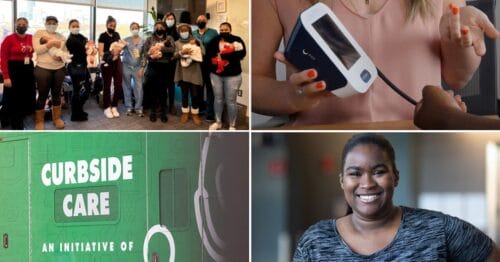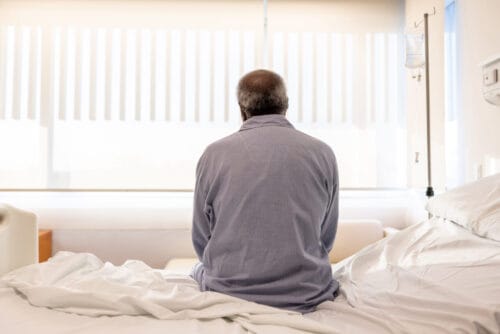Binge Eating Disorders Among Black Women Are Going Undiagnosed
March 1, 2023
By Sadiyah Anderson, By Yasmine Anderson, By Chance Carter, By Aissatou Mbengue, By Marc Merriman, Jr., By Cheyenne Roberts, By Henrietta Denise Ssettimba, By Olivia Taylor

Getty Images
Common screening tools lack the cultural competence to effectively diagnose and help Black women who are living with eating disorders, particularly binge eating.
Research around why someone develops an eating disorder is primarily centered around white women and their experiences. For example, the SCOFF questionnaire, a common screening tool for eating disorders that was developed in the 1990s, consistently lacks the depth to explain differences between racial demographic experiences. The absence of investigation and data into how Black women experience eating disorders dramatically increases disparities in both diagnosis and treatment, not to mention stigma and shame for Black women who do develop disordered eating.
For too long, the culturally competent narrative of nutrition and wellness for the Black community has been pushed to the shadows, but instead, it should be highlighted as one of the largest medical crises our country faces generationally.
Binge eating disorders among Black women
It is essential to reflect upon public perception of eating disorders and their cultural impact. For one, eating disorders are vastly nuanced, and despite being the most recognized, are not restricted to anorexia and bulimia.
When a person has anorexia or bulimia, their outward appearance tends to change in ways that are more likely spark notice from the person’s medical team or loved ones, causing concern for their health and, ideally, leading to intervention and treatment.
In contrast, Black women are more likely to have binge eating disorders, at about 5% compared to 2.5% among non-Hispanic white women. Binge eating, by comparison and especially within Black communities, can show in an outward physical expression that can often be praised for being regarded as a “fuller figure” or “stepping into one’s womanhood.” This praise makes it far less likely that a Black woman with a binge eating disorder will seek or receive intervention and help.
Cultural impact can play a significant role in our perception of eating disorders—specifically, why Black women have been left out of the eating disorder conversation to the extent that binge eating is not seen as serious an issue as anorexia and bulimia.
A famous example of this is Tyra Banks. Banks is notably one of the first Black models to break out in the industry and be deemed a “supermodel”—she was the first Black model to be featured on the cover of GQ and the Sports Illustrated: Swimsuit Edition, was a Victoria’s Secret Angel, and was the face of global brands like Nike, Pepsi, and CoverGirl.
Despite all these accolades within the modeling industry, she silently struggled with her weight throughout her entire career. In a 2014 interview, she discusses the irony of having been deemed too thin by the Black community during her modeling career, but a “thicker” model by individuals within the industry. She then describes her cycle of binge eating and food restriction. Still, amid her binge eating habits, no one identified her as unhealthy or possibly having an eating disorder. Most notably, it wasn’t deemed an issue by members of her own community.
Historic context and cultural influences of binge eating disorders
Historically, Black women were more likely than white women to have higher BMIs and less likely to engage in self-induced vomiting —perhaps in part due to Black women have little to no media representation standards of which to unhealthily compare themselves. But, culturally—for example, the culture around soul food in family gatherings and religious congregation spaces—there is more of a desire to become shapely instead of thinner.
Boston Medical Center’s Kelly Fournier, LICSW, an outpatient integrated behavioral health clinician at BMC’s Nutrition, Weight Management, Diabetes & Endocrinology Clinic discusses the idea or eating with your head and heart instead of having eating driven by hunger.
“There is ‘head hunger’, or what we would call emotional eating verses actual physiological hunger,” Fournier says. “The first step would be to help the patient identify what actual hunger might feel like for them and then exploring the question: ‘Are we eating more when we are stressed, bored, or anxious?’ And then, ‘What are the triggers to this possibility?’ We want to be able to separate emotional hunger from physiological hunger.”
“The first step would be to help the patient identify what actual hunger might feel like for them and then exploring the question: ‘Are we eating more when we are stressed, bored, or anxious?’ And then, ‘What are the triggers to this possibility?’ We want to be able to separate emotional hunger from physiological hunger.”
If it’s more of the latter, Fournier says providers have to think: “How do we help to navigate that so you’re not utilizing food to cope with emotions?”
Navigating this space around using food to cope with anxiety, stress, or boredom is a fine line between socioeconomic status and accessibility. Black patients are more likely to live in food deserts or food swamps, where access to nutritional food is lacking. As a result, Black patients are at disproportionately high risk of suffering from an array of health conditions, including high cholesterol, diabetes, prediabetes, high blood pressure, and sleep apnea.
Research also suggests that Black women are less likely than white women to seek eating disorder treatment, and even when engaged, are more likely to drop out. It is the responsibility of clinicians to reform approaches to treatment that address the psychopathology of the motivation behind binge eating in Black women for optimal treatment retention.
How to move forward with culturally competent eating disorder care
Reforming the SCOFF questionnaire system for Black patients would be the most effective way to proactively address clinical minority eating disorders in the future.
A good model of this is in Brazil, where we researched using cultural adaptation and validation in the SCOFF questionnaire for a university population. Their culturally competent questionnaire cross-sectionally observes, primarily, bulimia nervosa, binge eating disorder, and anorexia nervosa. However, there are at least 14 other culturally adapted screening instruments worldwide to assess eating disorders—and none of which include Black patients.
Research also suggests that Black women are less likely than white women to seek eating disorder treatment, and even when engaged, are more likely to drop out.
In a true culturally adaptive SCOFF questionnaire for Black patients, factors determined by culture and socioeconomic status (for example, soul food and food deserts, respectively) should be properly noted not only in the diagnosing stage but also in the treatment stage of Black patients with disordered eating and further maladaptive habits.
For more successful recovery rates, we believe clinicians should focus on three major solutions:
- Advocating for Appetite Awareness Training, a cognitive-behavioral treatment to improve maladaptive eating behaviors
- Holding sessions in common, trusted community locations
- Prioritizing acknowledgment of the role race plays in eating disorders, which helps Black patients feel understood and increases treatment completion.
Healthcare cannot effectively help Black women with eating disorders if they aren’t aware they have a problem in the first place. There needs to be more awareness and education that habits of binge eating are in fact a pattern of disordered eating, at the same level as the more commonly recognized anorexia and bulimia, which are more common in white women.
All authors are members of Black Women in Charge, Inc, ia non-profit 501(c)(3) organization based in Indianapolis, Indiana. Its members consist of college students all over the nation from many disciplines that all share a passion in advocating for justice.


